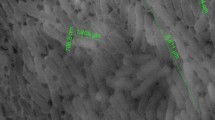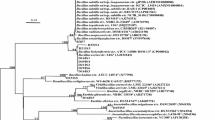Abstract
Bacillus subtilis is a versatile bacterial species able to produce surfactin, a lipopeptide biosurfactant. We carried out the phylogenomic characterization and pangenomic analyses using available B. subtilis complete genomes. Also, we report the whole genome of the biosurfactant-producing B. subtilis strain RI4914 that was isolated from effluent water from an oil exploration field. We applied a hybrid sequencing approach using both long- and short-read sequencing technologies to generate a highly accurate, single-chromosome genome. The pangenomics analysis of 153 complete genomes classified as B. subtilis retrieved from the NCBI shows an open pangenome composed of 28,511 accessory genes, which agrees with the high genetic plasticity of the species. Also, this analysis suggests that surfactin production is a common trait shared by members of this species since the srfA operon is highly conserved among the B. subtilis strains found in most of the assemblies available. Finally, increased surfactin production corroborates the higher srfAA gene expression in B. subtilis strain RI4914.







Similar content being viewed by others
References
Van Hamme JD, Singh A, Ward OP (2006) Physiological aspects. Biotechnol Adv 24:604–620. https://doi.org/10.1016/j.biotechadv.2006.08.001
Abbasi H, Hamedi MM, Lotfabad TB, Zahiri HS, Sharafi H, Masoomi F et al (2012) Biosurfactant-producing bacterium, Pseudomonas aeruginosa MA01 isolated from spoiled apples: physicochemical and structural characteristics of isolated biosurfactant. J Biosci Bioeng 113:211–219
Desai JD, Banat IM (1997) Microbial production of surfactants and their commercial potential. Microbiol Mol Biol Rev 61:47–64
Lima TMS, Procópio LC, Brandão FD, Leão BA, Tótola MR, Borges AC (2011) Evaluation of bacterial surfactant toxicity towards petroleum degrading microorganisms. Bioresour Technol 102:2957–2964
Lima TMS, Procópio LC, Brandão FD, Carvalho AMX, Tótola MR, Borges AC (2011) Biodegradability of bacterial surfactants. Biodegradation 22:585–592. https://doi.org/10.1007/s10532-010-9431-3
Maia M, Capão A, Procópio L (2019) Biosurfactant produced by oil-degradingPseudomonas putidaAM-b1 strain with potential for microbial enhanced oil recovery. Bioremediat J 23:302–310
Harwood CR, Mouillon J-M, Pohl S, Arnau J (2018) Secondary metabolite production and the safety of industrially important members of the Bacillus subtilis group. FEMS Microbiol Rev 42:721–738
Fernandes PL, Rodrigues EM, Paiva FR, Ayupe BAL, McInerney MJ, Tótola MR. (2016) Biosurfactant, solvents and polymer production by Bacillus subtilis RI4914 and their application for enhanced oil recovery. Fuel 180:551–557. https://doi.org/10.1016/j.fuel.2016.04.080
Willenbacher J, Yeremchuk W, Mohr T, Syldatk C, Hausmann R (2015) Enhancement of Surfactin yield by improving the medium composition and fermentation process. AMB Express 5:145
Zhi Y, Wu Q, Xu Y (2017) Genome and transcriptome analysis of surfactin biosynthesis in Bacillus amyloliquefaciens MT45. Sci Rep 7:40976
Wu B, Xiu J, Yu L, Huang L, Yi L, Ma Y (2022) Biosurfactant production by Bacillus subtilis SL and its potential for enhanced oil recovery in low permeability reservoirs. Sci Rep 12:7785
Madsen JK, Pihl R, Møller AH, Madsen AT, Otzen DE and Andersen KK (2015) The anionic biosurfactant rhamnolipid does not denature industrial enzymes. Front Microbiol 6:292. https://doi.org/10.3389/fmicb.2015.00292
Kim Y, Koh I, Young Lim M, Chung W-H, Rho M (2017) Pan-genome analysis of Bacillus for microbiome profiling. Sci Rep 7:10984
Brito PH, Chevreux B, Serra CR, Schyns G, Henriques AO, Pereira-Leal JB (2018) Genetic competence drives genome diversity in Bacillus subtilis. Genome Biol Evol 10:108–124
Borriss R, Danchin A, Harwood CR, Médigue C, Rocha EPC, Sekowska A, et al. (2018) Bacillus subtilis,the model Gram-positive bacterium: 20 years of annotation refinement. Microb Biotechnol 11:3–17. https://doi.org/10.1111/1751-7915.13043
Kunst F, Ogasawara N, Moszer I, Albertini AM, Alloni G, Azevedo V et al (1997) The complete genome sequence of the gram-positive bacterium Bacillus subtilis. Nature 390:249–256
Larkin MA, Blackshields G, Brown NP, Chenna R, McGettigan PA, McWilliam H, et al. (2007) Clustal W and Clustal X version 2.0. Bioinformatics 23:2947–2948. https://doi.org/10.1093/bioinformatics/btm404
Pfaffl MW (2001) A new mathematical model for relative quantification in real-time RT-PCR. Nucleic Acids Res 29:e45
Steibel JP, Poletto R, Coussens PM, Rosa GJM (2009) A powerful and flexible linear mixed model framework for the analysis of relative quantification RT-PCR data. Genomics 94:146–152
Koren S, Walenz BP, Berlin K, Miller JR, Bergman NH, Phillippy AM (2017) Canu: scalable and accurate long-read assembly via adaptive -mer weighting and repeat separation. Genome Res 27:722–736
Vaser R, Sović I, Nagarajan N, Šikić M (2017) Fast and accurate de novo genome assembly from long uncorrected reads. Genome Res 27:737–746
Li H, Durbin R (2009) Fast and accurate short read alignment with Burrows-Wheeler transform. Bioinformatics 25:1754–1760
Parks DH, Imelfort M, Skennerton CT, Hugenholtz P, Tyson GW (2015) CheckM: assessing the quality of microbial genomes recovered from isolates, single cells, and metagenomes. Genome Res 25:1043–1055
Meier-Kolthoff JP, Carbasse JS, Peinado-Olarte RL, Göker M (2021) TYGS and LPSN: a database tandem for fast and reliable genome-based classification and nomenclature of prokaryotes. Nucleic Acids Res. https://doi.org/10.1093/nar/gkab902
Richter M, Rosselló-Móra R, Oliver Glöckner F, Peplies J (2016) JSpeciesWS: a web server for prokaryotic species circumscription based on pairwise genome comparison. Bioinformatics 32:929–931
Wattam AR, Abraham D, Dalay O, Disz TL, Driscoll T, Gabbard JL et al (2014) PATRIC, the bacterial bioinformatics database and analysis resource. Nucleic Acids Res 42:D581–D591
Tatusova T, DiCuccio M, Badretdin A, Chetvernin V, Nawrocki EP, Zaslavsky L et al (2016) NCBI prokaryotic genome annotation pipeline. Nucleic Acids Res 44:6614–6624
Edgar RC (2004) MUSCLE: multiple sequence alignment with high accuracy and high throughput. Nucleic Acids Res 32:1792–1797
Huelsenbeck JP, Ronquist F (2001) MRBAYES: Bayesian inference of phylogenetic trees. Bioinformatics 17:754–755
Page AJ, Cummins CA, Hunt M, Wong VK, Reuter S, Holden MTG et al (2015) Roary: rapid large-scale prokaryote pan genome analysis. Bioinformatics 31:3691–3693
Seemann T (2014) Prokka: rapid prokaryotic genome annotation. Bioinformatics 30:2068–2069. https://doi.org/10.1093/bioinformatics/btu153
Katoh K, Standley DM (2013) MAFFT multiple sequence alignment software version 7: improvements in performance and usability. Mol Biol Evol 30:772–780
Stamatakis A (2014) RAxML version 8: a tool for phylogenetic analysis and post-analysis of large phylogenies. Bioinformatics 30:1312–1313
Sohail R, Jamil N. (2019) Isolation of biosurfactant producing bacteria from Potwar oil fields: effect of non-fossil fuel based carbon sources. Green Process Synth 9:77–86. https://doi.org/10.1515/gps-2020-0009
Alvarez VM, Jurelevicius D, Marques JM, de Souza PM, de Araújo LV, Barros TG et al (2015) Bacillus amyloliquefaciens TSBSO 3.8, a biosurfactant-producing strain with biotechnological potential for microbial enhanced oil recovery. Colloids Surf B Biointerfaces 136:14–21
Wu H, Wang D, Gao F (2021) Toward a high-quality pan-genome landscape of Bacillus subtilis by removal of confounding strains. Brief Bioinform 22:1951–1971. https://doi.org/10.1093/bib/bbaa013
Rasmussen S, Nielsen HB, Jarmer H (2009) The transcriptionally active regions in the genome of Bacillus subtilis. Mol Microbiol 73:1043–1057
Adékambi T, Drancourt M, Raoult D (2009) The rpoB gene as a tool for clinical microbiologists. Trends Microbiol 17:37–45
Ki J-S, Zhang W, Qian P-Y (2009) Discovery of marine Bacillus species by 16S rRNA and rpoB comparisons and their usefulness for species identification. J Microbiol Methods 77:48–57
Zhang S-J, Du X-P, Zhu J-M, Meng C-X, Zhou J, Zuo P (2020) The complete genome sequence of the algicidal bacterium Bacillus subtilis strain JA and the use of quorum sensing to evaluate its antialgal ability. Biotechnol Rep 25:e00421. https://doi.org/10.1016/j.btre.2020.e00421
Stice SP, Stumpf SD, Gitaitis RD, Kvitko BH, Dutta B (2018) Genetic diversity analysis reveals limited genomic diversity as well as accessory genes correlated with onion pathogenicity. Front Microbiol 9:184
Snipen L, Almøy T, Ussery DW (2009) Microbial comparative pan-genomics using binomial mixture models. BMC Genomics 10:385
Rouli L, Merhej V, Fournier P-E, Raoult D (2015) The bacterial pangenome as a new tool for analysing pathogenic bacteria. New Microbes New Infect 7:72–85
Coleman JJ, Rounsley SD, Rodriguez-Carres M, Kuo A, Wasmann CC, Grimwood J et al (2009) The genome of Nectria haematococca: contribution of supernumerary chromosomes to gene expansion. PLoS Genet 5:e1000618
Choi HJ, Shin D, Shin M, Yun B, Kang M, Yang H-J et al (2020) Comparative genomic and functional evaluations of Bacillus subtilis newly isolated from Korean traditional fermented foods. Foods 9:1805. https://doi.org/10.3390/foods9121805
Funding
This work was supported by the National Council for Scientific and Technological Development (Conselho Nacional de Desenvolvimento Científico e Tecnológico/CNPq—project grant number 404651/2018–6). AMV received a research fellowship from the Conselho Nacional de Desenvolvimento Científico e Tecnológico (CNPq) (#303061/2019–7). JKLF also received a research fellowship from the Conselho Nacional de Desenvolvimento Científico e Tecnológico (CNPq) (#133550/2019–2). This research was supported by Coordenação de Aperfeiçoamento de Pessoal de Nível Superior — Brasil (CAPES) — Finance Code 001. This work was also supported by the Brazilian Microbiome Project (http://www.brmicrobiome.org).
Author information
Authors and Affiliations
Corresponding author
Ethics declarations
Conflict of interest
The authors declare no competing interests.
Additional information
Publisher's note
Springer Nature remains neutral with regard to jurisdictional claims in published maps and institutional affiliations.
Responsible Editor: Luiz Henrique Rosa
Supplementary Information
Below is the link to the electronic supplementary material.
Rights and permissions
Springer Nature or its licensor holds exclusive rights to this article under a publishing agreement with the author(s) or other rightsholder(s); author self-archiving of the accepted manuscript version of this article is solely governed by the terms of such publishing agreement and applicable law.
About this article
Cite this article
de Lima Ferreira, J.K., de Mello Varani, A., Tótola, M.R. et al. Phylogenomic characterization and pangenomic insights into the surfactin-producing bacteria Bacillus subtilis strain RI4914. Braz J Microbiol 53, 2051–2063 (2022). https://doi.org/10.1007/s42770-022-00815-0
Received:
Accepted:
Published:
Issue Date:
DOI: https://doi.org/10.1007/s42770-022-00815-0




